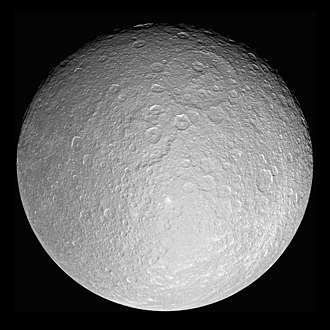Rhea (moon)
Rhea (/ˈriːə/;[a] Ancient Greek: Ῥέᾱ) is Saturn's second largest moon. It is made of ice and rock.
 Cassini view of Rhea's anti-Saturnian hemisphere, showing the moon's two largest impact basins (Mamaldi above and left of center, and adjacent Tirawa to its upper right). At highest resolution, several long linear features are visible: halfway down from center is Harahvaiti Fossa, while near the limb left of the bottom is Koykamou Catena. | |||||||||
| Discovery | |||||||||
|---|---|---|---|---|---|---|---|---|---|
| Discovered by | G. D. Cassini | ||||||||
| Discovery date | December 23, 1672 | ||||||||
| Designations | |||||||||
| Saturn V | |||||||||
| Adjectives | Rhean | ||||||||
| Orbital characteristics [1] | |||||||||
| 527 108 km | |||||||||
| Eccentricity | 0.001 258 3 | ||||||||
| 4.518 212 d | |||||||||
| Inclination | 0.345° (to Saturn's equator) | ||||||||
| Satellite of | Saturn | ||||||||
| Physical characteristics | |||||||||
| Dimensions | 1532.4×1525.6×1524.4 km | ||||||||
Mean radius | 763.8 ± 1.0 km | ||||||||
| 7 337 000 km² | |||||||||
| Mass | (2.306 518 ± 0.000 353)×1021 kg (~3.9×10−4 Earths) | ||||||||
Mean density | 1.236 ± 0.005 g/cm³ | ||||||||
| 0.265 m/s² | |||||||||
| 0.635 km/s | |||||||||
| 4.518 212 d (synchronous) | |||||||||
| zero | |||||||||
| Albedo | 0.949 ± 0.003 (geometric) | ||||||||
| |||||||||
| 10 [2] | |||||||||
Ring system
Main page: Rings of Rhea
Rhea may have a thin ring system with three narrow bands in a disk of solid particles. These would be the first rings seen around a moon. The discovery was announced in the journal Science on March 6, 2008.
Rhea (moon) Media
Closeup showing two craters on Rhea's surface taken in 2013 by Cassini spacecraft
View of Rhea's leading hemisphere with crater Inktomi and its prominent ray system just below center; impact basin Tirawa is at upper left
Notes
References
| Wikimedia Commons has media related to Lua error in Module:Commons_link at line 62: attempt to index field 'wikibase' (a nil value).. |
- ↑ Natural Satellites Ephemeris Service Minor Planet Center
- ↑ Observatorio ARVAL (April 15, 2007). "Classic Satellites of the Solar System". Observatorio ARVAL. Archived from the original on 2013-10-22. Retrieved 2011-12-17.






